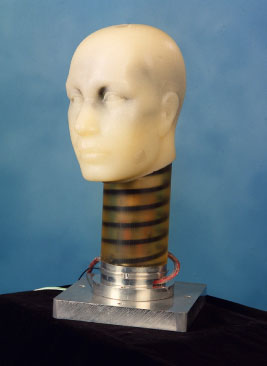
DERAMan – the dummy with brains

DERAMan – the dummy with brains
Most dummies have no brains. The average crash-test dummy has a hollow aluminum head containing just one accelerometer that measures x-y-z forces on impact.
DERA
A team led by Dr Sandra Bell at the UK Defence Evaluation Research Agency (DERA) has developed a dummy that is all head: DERAMan – an artificial head – produces 90 signals, and, with the right connections, that may make it the most intelligent dummy in the world.
DERAMan
DERAMan models what impacts to the skull do to the human brain. That matters. Thousands die each year from brain injuries; thousands more spend the rest of their lives disabled. DERAMan represents the best effort so far at facing up to this issue with an accurate model of the human head. This model can then undergo physical abuse in experiments that test for ways to avoid the damage that usually goes along with that abuse.
Material Composition
The material composition of the model head varies in the same way the human head does – at least in the way different parts of it react to impacts to the skull. Three basic components, mixed in different proportions, produce a wide range of polymers that mimic the relevant physical properties of the human tissue found in various parts of the head. The model brain behaves, in physical terms, very like the real one: shearing force from a glancing blow to the skull makes the model brain twist as if made of Jello, and maybe tear apart; compression, transmitted either from a direct blow or indirectly up the spine, makes the model brain bounce back and forth in the skull, creating a local partial vacuum at each bounce, and this – in real people – can cause the blood to boil and burst out of the veins and arteries in the brain.
Intelligent Triggering in a Crash-Test Dummy
Signals... connect to [sample-and-hold] boards that take their timing from a single clock signal generated by the DAP they connect to.
A signal on any input can act as the trigger. The associated DAP watches this input for a preset trigger level that indicates the beginning of the experiment. Meanwhile the system has continually sampled, buffered, and then discarded unwanted data. After the trigger event, the system continues to sample data, only it now does not discard data but buffers – and then transfers to the PC – the block of data surrounding the trigger event.
The block of data surrounding the trigger event includes a specified number of pretrigger samples; so the system captures all relevant data.
Matching Sensors
The many sensors embedded in the model tissue to relay the strengths of the various forces as they arise can themselves have an effect on the overall composition of the model head. The DERA team has gone to great lengths to develop sensors with physical characteristics similar to the surrounding material. Some sensors measure shear waves, others measure compression waves, yet others measure the forces of motion: 40 piezoelectric polymer sensors inside the model brain generate a small charge when squeezed; 45 piezoelectric ceramic sensors on the inside surface of the skull measure pressure changes there; and two accelerometers and the standard three-dimensional force gauge bring the final total to 90 inputs.
Simultaneous Sampling
Signals from DERAMan, collected in a bundle of wires that trail down the neck from the head, connect to MSXB 028 Simultaneous Sampling boards that take their timing from a single clock signal generated by the DAP they connect to.
With two DAP 3400a/445 data acquisition processor boards linked together by their onboard intelligence in a master/slave configuration, and with MSXB 028 expansion boards attached, the team at DERA can sample signals simultaneously at a rate of up to 36.4 K samples per second per channel on all 90 channels. By sampling the signals simultaneously, the team can correctly monitor how the different pressure waves propagate through the model brain.
PC versus VXI
With data flowing at a rate of over 3.2 million samples per second, it takes a very special PC-based system to cope. Without a DAP in the picture, most people would say: Forget PC, go VXI – and pay maybe twice as much. With a DAP, however, onboard intelligence once again comes to the rescue.
Triggering
By using the special software triggering features built into the onboard intelligence in every DAP, the DERA team selects only the data of interest to the experiment – without any additional hardware triggering lines to tell the DAP when the experiment begins or ends. A signal on any input can act as the trigger. The associated DAP watches this input for a preset trigger level that indicates the beginning of the experiment. Meanwhile the system has continually sampled, buffered, and then discarded unwanted data. After the trigger event, the system continues to sample data, only it now does not discard data but buffers – and then transfers to the PC – the block of data surrounding the trigger event. The block of data surrounding the trigger event includes a specified number of pretrigger samples; so the system captures all relevant data for the DERA team to analyze.
Intelligent Design
Connect intelligent sensor design at DERA with the onboard intelligence unique to a DAP, and what do you get? A dummy with brains.
Browse other customer applications.